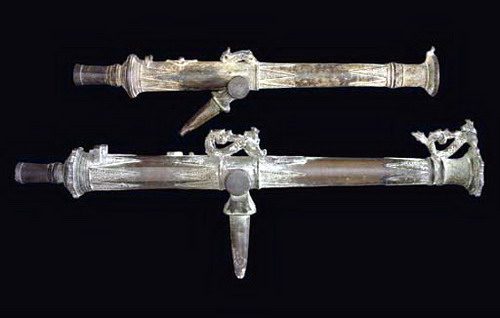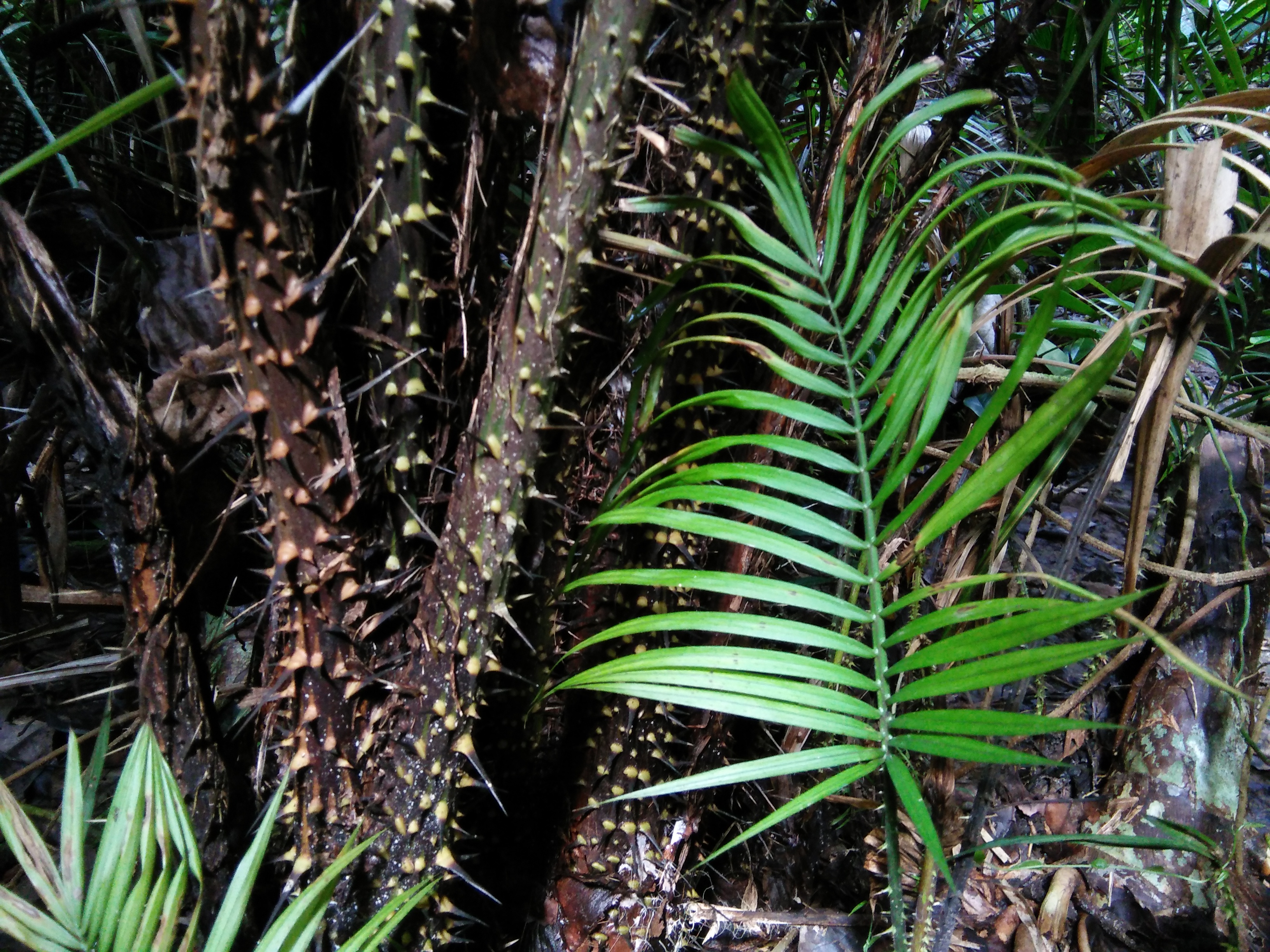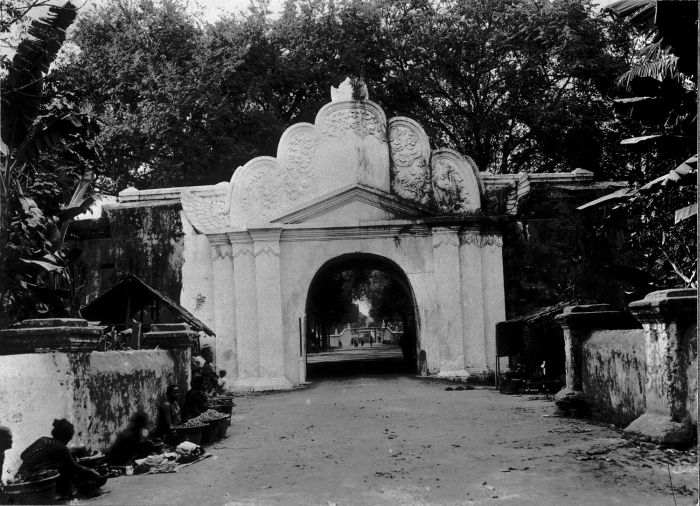|
Kota Mara
Apilan and kota mara are two Malay nautical terms which refers to the structure on a vessel where the cannon is installed. This term is used especially on Malay ships and boats. Apilan Apilan (or ampilan) is the wooden gunshield found in Malay prahus where cannons are placed. It has a hole to place long gun, and sometimes swivel gun can be placed over the top of the apilan. Apilan is not permanent, it can be assembled, disassembled, and moved. The crew of Malay prahu operated the long gun behind an apilan. The apilan usually situated at the bow of a prahu. This gun-shield was only put on when the ship went into action. Sunting apilan is the name given to two lelas or light guns standing on the gun-shield of a heavy gun. Etymology Apilan is a true Malay word, it was not descended from any word. It is also a standalone word, because the syllable is api-lan instead of apil-an. Kota mara Kota mara is the breastwork or casement of Malay prahus. The function is to prot ... [...More Info...] [...Related Items...] OR: [Wikipedia] [Google] [Baidu] |
Malay Prahu Warboat (1863)
Malay may refer to: Languages * Malay language or Bahasa Melayu, a major Austronesian language spoken in Indonesia, Malaysia, Brunei and Singapore ** History of the Malay language, the Malay language from the 4th to the 14th century ** Indonesian language, the official form of the Malay language in Indonesia ** Malaysian Malay, the official form of the Malay language in Malaysia * Malayic languages, a group of closely related languages in the Malay Archipelago * Malay dialects and varieties, distribution of dialects and varieties of the Malay language spread mainly in Southeast Asia * Malay trade and creole languages, a set of pidgin languages throughout the Sumatra, Malay Peninsula and the entire Malay archipelago * Brunei Malay, a variety of the Malay language spoken in Brunei, distinct from standard Malay * Kedah Malay, a variety of the Malay languages spoken in Malaysia and Thailand * Sri Lanka Malay language, spoken by the Malay race minority in Sri Lanka * Kelantan–Pattan ... [...More Info...] [...Related Items...] OR: [Wikipedia] [Google] [Baidu] |
Bas-Relief
Relief is a sculptural method in which the sculpted pieces remain attached to a solid background of the same material. The term ''relief'' is from the Latin verb , to raise (). To create a sculpture in relief is to give the impression that the sculpted material has been raised above the background plane. When a relief is carved into a flat surface of stone (relief sculpture) or wood ( relief carving), the field is actually lowered, leaving the unsculpted areas seeming higher. The approach requires chiselling away of the background, which can be time-intensive. On the other hand, a relief saves forming the rear of a subject, and is less fragile and more securely fixed than a sculpture in the round, especially one of a standing figure where the ankles are a potential weak point, particularly in stone. In other materials such as metal, clay, plaster stucco, ceramics or papier-mâché the form can be simply added to or raised up from the background. Monumental bronze reliefs are ... [...More Info...] [...Related Items...] OR: [Wikipedia] [Google] [Baidu] |
Shipbuilding
Shipbuilding is the construction of ships and other Watercraft, floating vessels. In modern times, it normally takes place in a specialized facility known as a shipyard. Shipbuilders, also called shipwrights, follow a specialized occupation that traces its roots to before recorded history. Until recently, with the development of complex non-maritime technologies, a ship has often represented the most advanced structure that the society building it could produce. Some key industrial advances were developed to support shipbuilding, for instance the sawing of timbers by Saw#Mechanically powered saws, mechanical saws propelled by windmills in Dutch shipyards during the first half of the 17th century. The design process saw the early adoption of the logarithm (invented in 1615) to generate the curves used to produce the shape of a hull (watercraft), hull, especially when scaling up these curves accurately in the mould Lofting, loft. Shipbuilding and ship repairs, both commercial an ... [...More Info...] [...Related Items...] OR: [Wikipedia] [Google] [Baidu] |
Watercraft Components
A watercraft or waterborne vessel is any vehicle designed for travel across or through water bodies, such as a boat, ship, hovercraft, submersible or submarine. Types Historically, watercraft have been divided into two main categories. *Rafts, which gain their buoyancy from the fastening together of components that are each buoyant in their own right. Generally, a raft is a "flow through" structure, whose users would have difficulty keeping dry as it passes through waves. Consequently, apart from short journeys (such as a river crossing), their use is confined to warmer regions (roughly 40° N to 40° S). Outside this area, use of rafts at sea is impracticable due to the risks of exposure to the crew. *Boats and ships, which float by having the submergeable part of their structure exclude water with a waterproof surface, so creating a space that contains air, as well as cargo, passengers, crew, etc. In total, this structure weighs less than the water that would occupy the sa ... [...More Info...] [...Related Items...] OR: [Wikipedia] [Google] [Baidu] |
Swivel Gun
A swivel gun (or simply swivel) is a small cannon mounted on a swiveling stand or fork which allows a very wide arc of movement. Another type of firearm referred to as a swivel gun was an early flintlock combination gun with two barrels that rotated along their axes to allow the shooter to switch between either the rifling, rifled or the smoothbore barrels. Swivel guns should not be confused with pivot guns, which were far larger weapons mounted on a horizontal pivot, or RML 2.5 inch Mountain Gun, screw guns, which are a mountain gun with a segmented barrel. An older term for the type is peterero (alternative spellings include "paterero" and "pederero"). The name was taken from the Spanish name for the gun, pedrero, a combination of the word piedra (stone) and the suffix -ero (-er), because stone was the first type of ammunition fired. It had a high rate of fire, as several chambers could be prepared in advance and quickly fired in succession and was especially effective in ant ... [...More Info...] [...Related Items...] OR: [Wikipedia] [Google] [Baidu] |
Riau-Lingga Sultanate
Riau-Lingga Sultanate ( Jawi: , ''Kesultanan Riau-Lingga''), also known as the Lingga-Riau Sultanate, Riau Sultanate or Lingga Sultanate was a Malay sultanate that existed from 1824 to 1911, before being dissolved following Dutch intervention. The sultanate came into existence as a result of the partition of the Johor-Riau Sultanate that separated Johor on the Malay Peninsula and the island of Singapore, from the Riau Archipelago. This partition followed the succession dispute following the death of Mahmud III of Johor, when Abdul Rahman was crowned as the first Sultan of Riau-Lingga. The maritime kingdom was recognised by both the British and the Dutch following the Anglo-Dutch Treaty of 1824. Its historical territory is almost parallel to the present-day Riau Islands Province, Indonesia. History Background The Riau Archipelago became a part of the Malaccan Sultanate after the expansion by Tun Perak in the 15th century, following the decline of the Srivijaya Emp ... [...More Info...] [...Related Items...] OR: [Wikipedia] [Google] [Baidu] |
Rentaka
The ''Lantaka'' (Baybayin: pre virama: ''ᜎᜆᜃ'': post virama: ''ᜎᜈ᜔ᜆᜃ'') also known as ''rentaka'' (in Malay, jawi script: رنتاک) was a type of bronze portable cannon or swivel gun, sometimes mounted on merchant vessels and warships in Maritime Southeast Asia. It was commonly equipped by native seafaring vessels from the Philippines, Indonesia, Brunei, and Malaysia. Lela and rentaka are known by the Malays as ''meriam kecil'' (lit. "small cannon"), the difference is that rentaka is smaller in length and bore than a lela. and Lantakas are often called ''Kanyon'' in Filipino (literal meaning cannon). The ''lantaka'' was cited by the National Commission for Culture and the Arts of the Philippines as an intangible cultural heritage of the country under the 'Traditional Craftsmanship' category that the government may nominate in the UNESCO Intangible Cultural Heritage Lists. The documentation of the craft was aided by ICHCAP of UNESCO. Etymology The name may ... [...More Info...] [...Related Items...] OR: [Wikipedia] [Google] [Baidu] |
Rattan
Rattan, also spelled ratan (from Malay language, Malay: ''rotan''), is the name for roughly 600 species of Old World climbing palms belonging to subfamily Calamoideae. The greatest diversity of rattan palm species and genera are in the closed-Canopy (biology), canopy Old-growth forest, old-growth tropical forests of Southeast Asia, though they can also be found in other parts of tropical Asia and Africa. Most rattan palms are ecologically considered lianas due to their climbing habits, unlike other palm species. A few species also have tree-like or shrub-like habits. Around 20% of rattan palm species are economically important and are traditionally used in Southeast Asia in producing wickerwork furniture, baskets, Walking stick, canes, woven mats, Rope, cordage, and other handicrafts. Rattan canes are one of the world's most valuable non-timber forest products. Some species of rattan also have edible scaly fruit and heart of palm. Despite increasing attempts in the last 30 y ... [...More Info...] [...Related Items...] OR: [Wikipedia] [Google] [Baidu] |
Oncosperma Tigillarium
''Oncosperma tigillarium'', commonly known as ''Nibong palm'' is an Asian species of palm tree in the family Arecaceae. Description ''Oncosperma tigillarium'' grows to 12m (possibly up to 30m) in height in dense thickets of up to 50 palm trees. The trunks of the palms are covered with long black spines. ''Oncosperma tigilarium'' has finely pinnate leaves, with drooping leaflets. Common names Its common name in Indonesian is ''nibung'' meaning ''thorn'', for the long thorns that arise along the length of the trunk of the palm. In parts of the Philippines it is known as ''anibung'' in the Hiligaynon language. In Khmer it is called sla: ta 'aôn Distribution The species is known from inland, lower salinity waters, near mangrove swamps of southern Vietnam, Cambodia, the Philippines, Malaysia and Indonesia, in Southeast Asia. It is native to these areas west of the Wallace Line growing at elevations below 150 metres. It is endangered in some areas due to deforestation, and it is ... [...More Info...] [...Related Items...] OR: [Wikipedia] [Google] [Baidu] |
John Crawfurd
John Crawfurd (13 August 1783 – 11 May 1868) was a British physician, colonial administrator, diplomat and writer who served as the second and last resident of Singapore. Early life He was born on Islay, in Argyll, Scotland, the son of Samuel Crawfurd, a physician, and Margaret Campbell; and was educated at the school in Bowmore. He followed his father's footsteps in the study of medicine and completed his medical course at the University of Edinburgh in 1803, at the age of 20. Crawfurd joined the British East India Company, East India Company, as a Company surgeon, and was posted to India's Northwestern Provinces (now Uttar Pradesh), working in the area around Delhi and Agra from 1803 to 1808. He saw service in the campaigns of Gerard Lake, 1st Viscount Lake, Baron Lake. In the East Indies Crawfurd was sent in 1808 to Penang, where he applied himself to the study of the Malay language and culture. In Penang, he met Stamford Raffles for the first time. In 1811, Crawfurd ... [...More Info...] [...Related Items...] OR: [Wikipedia] [Google] [Baidu] |
Lanong Sketches By Rafael Monleón (1890)
''Lanong'' were large outrigger warships used by the Iranun people, Iranun and the Banguingui people, Banguingui people of the Philippines. They could reach up to in length and had two biped Shear legs, shear masts which doubled as boarding ladders. They also had one to three banks of oars rowed by galley slaves. They were specialized for naval battles. They were prominently used for Piracy in the Sulu Sea, piracy and Slavery in Sultanates of Southeast Asia, slave raids from the mid-18th century to the early 19th century in most of Southeast Asia. The name ''lanong'' is derived from ''Lanun'',''Lanun'' also became the word for "pirate" in the Malay language an exonym of the Iranun people. Like the ''karakoa'', large ''lanong'' were also known by the Spanish as ''joanga'' or ''juanga (ship), juanga'' (Spanish for "Junk (ship), junk"), a name which was also applied to other large ships in Southeast Asia. Description ''Lanong'' can reach up to long and wide amidships. They wer ... [...More Info...] [...Related Items...] OR: [Wikipedia] [Google] [Baidu] |
Sanskrit
Sanskrit (; stem form ; nominal singular , ,) is a classical language belonging to the Indo-Aryan languages, Indo-Aryan branch of the Indo-European languages. It arose in northwest South Asia after its predecessor languages had Trans-cultural diffusion, diffused there from the northwest in the late Bronze Age#South Asia, Bronze Age. Sanskrit is the sacred language of Hinduism, the language of classical Hindu philosophy, and of historical texts of Buddhism and Jainism. It was a lingua franca, link language in ancient and medieval South Asia, and upon transmission of Hindu and Buddhist culture to Southeast Asia, East Asia and Central Asia in the early medieval era, it became a language of religion and high culture, and of the political elites in some of these regions. As a result, Sanskrit had a lasting effect on the languages of South Asia, Southeast Asia and East Asia, especially in their formal and learned vocabularies. Sanskrit generally connotes several Indo-Aryan languages# ... [...More Info...] [...Related Items...] OR: [Wikipedia] [Google] [Baidu] |








